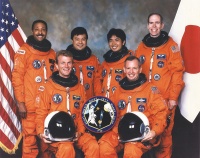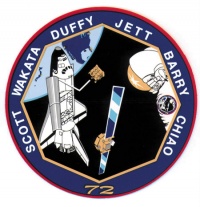STS-72
From The Space Library
 | |
| Organization | NASA-OfficeofSpaceFlight(UnitedStates) |
|---|---|
| Mission type | Human Crew |
| Launch date | January 11, 1996 |
| Launch vehicle | Space Shuttle |
| Carrier rocket | {$Carrier Rocket} |
| Launch site | Cape Canaveral, United States |
| COSPAR ID | 1996-001A |
| Mass | {$Mass} |
| Experiments | Here |
| Alternate Names | 23762 |
| Nominal Power | {$Nominal Power} |
| Additional Information | Here |
| Data Collection | Here |
| Payload Mass Up | 6510.0 kg |
STS 72 was a US shuttle spacecraft launched from Cape Canaveral. It carried, released, and retrieved the OAST Flyer. It also retrieved a long orbiting Japanese reusable spacecraft, SFU, that had amassed astronomical data and material science products since March 1995. The primary objective of the STS-72 mission was to capture and return to Earth a Japanese microgravity research spacecraft known as Space Flyer Unit (SFU). The 7,885lbs SFU spacecraft was launched by Japan's National Space Development Agency (NASDA) from Tanegashima Space Center in Japan at 8:01 UT on March 18, 1995 aboard a Japanese H-II rocket (HII-3). The STS-72 mission also deployed (for about 50 hours) and then retrieved the Office of Aeronautics and Space Technology Flyer (OAST-Flyer) spacecraft. OAST-Flyer was the seventh in a series of missions aboard reuseable free-flying Spartan carriers. It consisted of four experiments: Return Flux Experiment (REFLEX), Global Positioning System Attitude Determination and Control Experiment (GADACS), Solar Exposure to Laser Ordnance Device (SELODE) and the University of Maryland Spartan Packet Radio Experiment (SPRE). Other experiments onboard STS-72 included the Shuttle Solar Backscatter Ultraviolet Experiment (SSBUV-8) (previously flown on STS-34, STS-41, STS-43, STS-45, STS-56, STS-62 and STS-66), EDFT-03, Shuttle Laser Altimeter Payload (SLA-01/GAS(5)), VDA-2, National Institutes of Health NIH-R3 Experiment, Space Tissue Loss Experiment (STL/NIH-C), Pool Boiling Experiment (PBE) (hardware previously flown on STS-47, STS-57 and STS-60) and the Thermal Energy Storage (TES-2) experiment (previously flown on STS-69). Get Away Special payloads included the United States Air Force Academy G-342 Flexible Beam Experiment (FLEXBEAM-2), Society of Japanese Aerospace Companies' G-459 - Protein Crystal Growth Experiment and the Jet Propulsion Laboratory GAS Ballast Can with Sample Return Experiment. Endeavour's 10th flight also included two 6.5 hour spacewalks by three astronauts to test hardware and tools that will be used in the assembly of the International Space Station starting in late 1997. EVA-1 on flight day five consists of Crewmembers Leroy Chiao (EV1) and Dan Barry (EV2) while EVA-2 on Flight Day 7 consists of Leroy Chiao (EV1) and Winston Scott (EV2).

